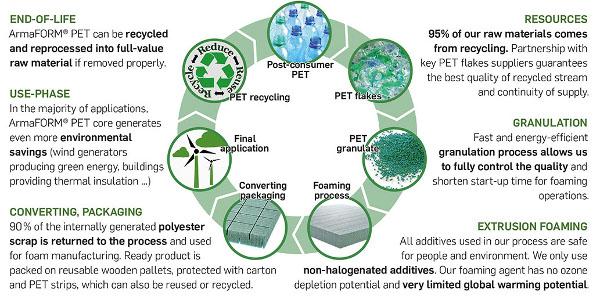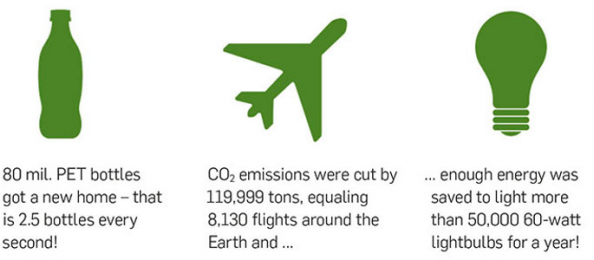What ArmaFORM PET achieved in 2016 (based on Armacell-internal calculations)
The Armacell PET Story – Turning Bottles Into Green Foam
The UN climate conference in Paris marked a turning point in global climate and energy policy: For the first time, all 195 member states of the UN Framework Convention on Climate Change committed themselves to protecting the climate and agreed to limit global warming to below 2 degrees Celsius. In order to build a low-carbon economy by 2050, the European Union aims to progressively reduce its greenhouse gas emissions by 80 percent compared to 1990.
This ambitious target can only be achieved if directives on increasing energy efficiency are implemented rigorously. All of us have to set the course for shaping these developments to ensure that they are sustainable – environmentally friendly, socially fair, and economically effi cient. Embracing responsibility for future generations means taking energy and resource savings into account when making decisions today. Buildings are good examples: Today, they are responsible for more than 40 percent of global energy consumption and account for one-third of the greenhouse gas emissions into our planet’s atmosphere.
Armacell and its green plastic – a contradiction?
In 2006, Armacell was the first manufacturer globally to successfully qualify Polyethylene Terephthalate (PET) – commonly known as the rigid and indestructible material of plastic beverage bottles – as a core material for the composite industry. Today, Armacell is one of only a few companies worldwide offering PET foam cores and the only manufacturer able to produce this material 100 percent made of post-consumer (recycled) PET material with consistent, reliable qualities. A “green” plastic? What sounds like a contradiction in terms is in fact a cutting-edge technology that took the Armacell global R&D team several years to develop. The green foam core meets not only stringent technical requirements for composites but also follows the guidelines for the circular economy and helps to preserve and enhance the human environment.
Made from 100 percent recycled PET: ArmaFORM® PET
PET foam core – made from 100 percent recycled PET – is innovative and unique in the world. It presents a real “green alternative” for decision-makers who are increasingly being confronted with a deciding factor: “What is the environmental impact of the product I am using?” Armacell’s PET product ArmaFORM ® PET is made from 100 percent post-consumer PET packaging materials and is fully recyclable. In the production process, no ozone-depleting HFC or CFC blowing agents are used, and all of the material loss is reused in internal recycling. Making post-consumer PET resin out of recycled PET requires 70 percent less energy and produces 80 percent less CO2 per unit than virgin PET resin. Using it for the foaming process of our Arma- FORM® PET foam core leads to excellent ecological results: The global warming potential (CO2 emission) can be reduced by 33 percent and the ozone depletion potential by 34 percent.
How green is it? The life cycle assessment
The environmental impact of Arma-FORM® PET has been evaluated by the life cycle assessment (LCA), which is the most commonly used tool to evaluate how green a product is, that is, what its real environmental impact is. The LCA systematically investigates the environmental impact of industrial goods by tracking their complete lifecycle from cradle to grave. All of the data represented in the Life Cycle Inventory are translated into potential human health and environmental impacts and expressed as factors such as global warming potential. In the data collection for the LCA, the following life stages are considered:
• raw material supply
• transport of materials to the production facility
• granulation of PET flakes
• foaming process
• post-operations
• transport from factory gate to customer site
The LCA has shown that ArmaFORM® PET outperforms any other foam core currently available on the composite market. It has much lower impacts on human health and the environment than virgin PET and is much more environmentally friendly than any other foam core available on the market. Instead of being land-fi lled or incinerated, the recycled PET returns to the system and, thanks to Armacell’s patented technology, is remanufactured into a full-value product. Based on these results, ArmaFORM® PET contributes to a more sustainable future and supports the guidelines of the circular economy, in which being environmentally and socially responsible goes hand in hand with running a profi table business.
It is also green in use!
In the majority of applications, Arma-FORM® PET core generates even more environmental savings. Since its introduction, one of the biggest markets for ArmaFORM® PET is wind energy, where it is used in sandwich constructions for rotor blades, nacelles, and spinners of windmills and, thus, supports the production of green energy. As of today, more than 40,000 rotor blades worldwide have been built using ArmaFORM® PET foam cores. In the final application in such turbines, energy is generated over a period of 20 years without creating emissions. The energy used in the production of raw materials and in construction is usually recovered within nine months.
For more information, please visit: www.armacell.com

About Us // Privacy Policy // Copyright Information // Legal Disclaimer // Contact
Copyright © 2012-2018 macondo publishing GmbH. All rights reserved.
The CSR Academy is an independent learning platform of the macondo publishing group.









